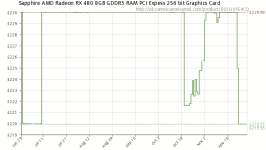Caporegime
LOL, going by that chart you have linked to there is a 23% difference between the 160 and the 480, that certainly isn't negliable.
Which is still much smaller than previously. The R9 390 and GTX970 had like a 60% difference and that was almost halved with the RX480 and the GTX1060.
OFC,its no point denying Nvidia has the edge.
Having said that they use different process nodes,and the RX480 uses more VRAM chips too. Look at the steppings on the Polaris 10 and 11 GPUs - they are apparently on a third respin. Global Foundries original 14NM failed miserably and they licensed what Samsung was using and apparently had issues with that too.
There is noise of AMD using Samsung too,so maybe if we see some Samsung made Polaris GPUs,we can see how much the design is behind Nvidia.
The problem is though that the GTX 1080 doesn't offer next-gen performance; it's basically a slight improvement over what we've had for a long time already - we need something close to the Titan X, but cheaper (so people can put them in CF/SLI), in order for 4K gaming to become a reality. The Titan X is the only decent card this gen imho, and we know nvidia haven't even unleashed the full potential of Pascal yet due to AMD lagging so far behind.
Sorry missed that - I get what you are saying but ultimately AMD needs to still have an answer to the GP104 first especially in manufacturing costs.
Remember,the best AMD has in a laptop is the mobile RX470 and Nvidia has a mobile GTX1080,and there is more likelihood of a prebuilt gaming PC having something like a GTX1070 or GTX1080.
AMD needs a card that can do qHD first.
There will be a larger Vega it appears,but my main worry with that is Nvidia has separate large die chip lines - ones for gaming and ones for commerical work. If AMD make a once size fits all chip,I suspect they will need to make some compromises. I expect a large die AMD chip will use HBM2 and be very expensive.





